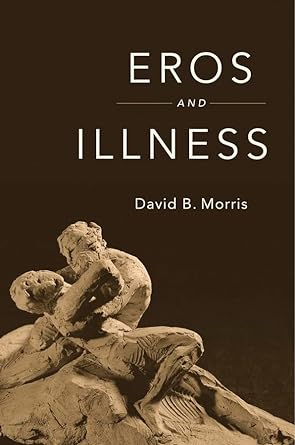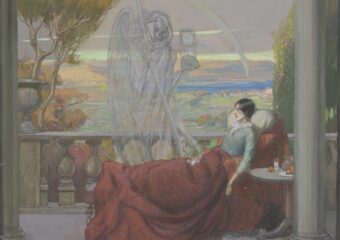David B. Morris
Cambridge, MA
Harvard University Press
2017
350 pages
According to the Art:
The author wants to “cross restrictive boundaries” between medical logos and medical eros so that desires connected to specific health problems can be recognized, reconciled, and remediated.
Synopsis:
Eros is spoken of mostly as the ancient Greek god of love ruling over desire in the form of sexual passion, lust. The writer, teacher, and scholar David B. Morris broadens the reach of desire to effects in “the arena of human health and illness,” which generally “encompasses all the various emotional, psychological, and personal implications.” (p. 8) Indeed, he quickly points out, “Eros, whatever it is, is not identical to sexual activity.” (p. 5) Accordingly, Morris’ objective with the book “is to recognize and begin to address the various, multidimensional roles of eros in illness,” (p. 10) towards a purpose of unleashing “a power that can help make the passage through illness far less onerous, a power that offers a more truly ‘personalized’ medicine than genetic profiles alone can promise.” (16)
Realizing that eros is unruly conceptually, being “more of a lens that offers an inside view of illness as a lived experience,” (p. 17) Morris gives considerable attention to making its relationship and application to health and illness comprehensible. He takes this on by first expanding eros in a way such that it can encompass health and illness.
Eros, in short, cannot be reduced to a concept. It is not accessible through propositions or argument. It is rather a primal force that, in its typical motion, sweeps us away, depriving us of reason, logic, and even coherent speech…Eros embraces desire in all its colorful and passionate varieties up to and including delirium.
p. 3
Morris then juxtaposes a broad construction of biomedicine with corresponding elements of eros. For this purpose, biomedicine is:
…a calling for scientific knowledge, for evidence-based treatments, and for public policies governed by statistical, cost-benefit analysis [that] encloses the patient within concentric systems of logos or reason that affect every aspect of medical care.
p. 7
And eros is:
…an exploration of desire in illness [that] depends on looking beyond (but not ignoring) randomized double-blind experiments; it means looking beyond (but not ignoring) telephone surveys and check-the-box questionnaires. It means especially focusing on such nonstandard biomedical data as memoirs, essays, paintings, performances, experiences, and images.
p.16
To bring a clearer distinction to this juxtaposition, Morris assigns “medical logos” to represent biomedical reasoning with all that goes into it, and assigns “medical eros” to represent the elements of desire applicable to health and illness. He wants to “cross restrictive boundaries” between medical logos and medical eros so that desires connected to specific health problems can be recognized, reconciled, and remediated.
Morris recounts the history of eros in illness, describing how the place eros inhabited in ancient medicine and as represented by Asklepios, the ancient Greek god of medicine, drew from myths and narratives of divine healing powers and desires (medical eros). It existed alongside Hippocratic medicine with its reliance on reason taken from knowledge of the body and empiric evidence (medical logos). Morris tells how the influence of eros in medicine faded away almost completely, not because of “a showdown or conspiracy but simply the advancement of science and the relentless triumph of a medical ideology.” (p. 62) He finds the sparks of the resurgence of medical eros during the first part of the twentieth-century evidenced from the writings of Virginia Woolf and others. The resurgence would build during the century with a rising chorus (e.g., Susan Sontag, Audre Lorde, Reynolds Price), and eventually become part of a nascent field known variously as medical humanities, health humanities, or humanistic medicine. Morris notes that while medical logos and medical eros are “contraries” in general terms, they need not be antagonists in their applications: “Emotion and reason, while sometimes at odds, are also often mutually supportive, rarely proceeding in absolute separation.” (87)
Medical eros becomes clearer with the many examples Morris provides from various genres. Among them include: writer, critic, teacher Anatole Broyard’s prostate cancer; writer William Styron’s severe depression; sociologist Barbara Rosenblum’s breast cancer; journalist Stephanie Nolen’s stories about AIDS in Africa; fashion magazine editor Jean-Dominique Bauby’s locked-in syndrome after a devastating stroke; dancer and choreographer Bill T. Jones’ performances and workshops about palliative care for AIDS; and artist Amedeo Modigliani’s painting of nudes while ravaged with tuberculosis. Morris describes how desire works in each of these cases. For example, in the case of Broyard, he explains how Broyard surprised his visitors who found him upbeat and heard him say, “I’m filled with desire—to live, to write, to do everything.” (pp. 53-54). “A Balthus painting on a postcard [gave] meaning to the passing hours” for Bauby. (p. 125) Modgiliani’s “nudes in their erotic health and dreamlike serenity contradict or hold at bay [his] hacking cough and blood-red sputum.” (pp. 158-159)
In contrast to scenarios in which medical eros has a place alongside where medical logos is at work, Morris considers scenarios—“dilemmas”—wherein medical logos is absent or ineffective and where medical eros could be applicable.
Medical logos runs on knowledge, so when facts and knowledge fail, it is pretty much in the dark. Medical eros, on the other hand, is less handicapped by not-knowing, and it has resources to offer when biomedical knowledge falls short. Rational answers—even when available—may prove less important in medical trauma than explanations that help clarify a surrounding field of emotion.
p. 266
Dilemmas he contemplates include: improbable events (“Black Swan Syndrome”); “problems of light damage;” and broadly construed “appearances” (cosmetic enhancement) and “disappearances” (“spark of life,” functional disabilities).
Morris works towards integrating medical eros and medical logos as a means of bringing “cultural and persona dimensions” into the understanding of health and illness. (p. 281)
I think of them working separately as needed, but often in concert, like the right hand and the left hand…Sometimes, too, words and images can help more than drugs and surgeries in situations where illness might seem to blot out eros and obliterate an assent to life.
pp. 299-300
And in so doing, he reifies the myths of Asklepios for application in modern-day health care.
Analysis:
Morris did not come to this topic in a random fashion. He has interests in how pathological states or conditions as discerned by biomedicine are translated into how people experience them. Particular interests of his are the cultural influences shaping these experiences, and the tensions between the two realms, the biomedical and the personal. The idea of eros and its connection to biomedicine became more personal to him when he found himself trapped “within their unseen, incessant crossfire” as caregiver for his wife, Ruth, who was succumbing to Alzheimer’s disease. (p. 7) Thus, he comes to this project as both scholar and practitioner. As such, his exploration of medical eros is aimed at “possibilities for scholarly study, for professional development, and most important, for individual change, healing, and solace.” (p. 17)
But even with Morris’ scaffolded definitions, explanations, and examples, medical eros can challenge anyone’s grasp of the idea and what to do with it. What can help bring more clarity to it is seeing how Morris’ aim converges with the field of medical humanities in its role of bringing works from the arts to bear on what people with health problems face. Referring to Bjørn Hofmann’s model of disease, iIllness, and sickness helps as well by isolating the illness component of health problems. In this model, disease refers to the pathophysiological basis of health problems, illness to what people noticeably experience, and sickness to societal responses. Medical eros attaches to the illness component of the model, and at the same time establishes it as a credible feature that is otherwise missing or obscured. Morris further situates medical eros in the illness component of health problems when he refers to the “molecular gaze.” He is evolving Foucault’s “medical gaze” as how disease is discerned from pathology at the level of tissue to his more precise “molecular gaze” of pathology at the molecular level, thereby sharpening the distinction between disease and illness as Hofmann characterizes them. When medical eros is positioned in this or similar models, it should become more visible and more easily applied to discerning and addressing particular health problems.
Medical eros, prima facie, can seem esoteric and a bit of academic mumbo jumbo not worthy of serious consideration in the care of anyone with a health problem. But, when it’s understood as the desires accompanying illness, it can help to explain some reactions people manifest and offer ideas for responses. Eros is not just for lovers.
Also:
I point to another example of medical eros in a blog piece on the play, Farinelli and the King.
Eros and Illness is the subject of an episode of the podcast, The Clinic & The Person.
Edited by Lucy Bruell



